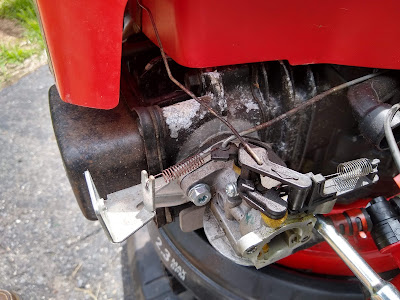I mentioned dad's pressure sprayer the other day. It's for an upcoming project I haven't told you about yet. I've been holding back because it's moving slowly but I'll have something soon.
Anyway lets talk a little more about that sprayer, it's been a bit of an adventure.
It's a Troy-Bilt 2700psi sprayer, kind of low end, they make these up to nearly 4000psi. This one is actually made, as far as I can tell, by Briggs and Stratton who also make the engine.
Dad bought it from a friend of his about 3 years ago. What he didn't tell me is that his friend hadn't run it in at least 5 years. Oh and it was stored with gas in it. The gas smelled BAD.
I'm not good at remembering to take pictures, this one was so I could remember how to put the linkages back in place on the carburetor. This carb has an "automatic choke" thats the rod running across the front of the engine, to the upper left in the picture. Over by the engine theres a thermostat that must move when the exhaust gets hot and opens the choke.
I wish I had taken a picture of the inside of the carb, the needle was stuck hard into the seat and there was some kind of goo in the gas intake so it wouldn't flow fuel. This picture was taken after the 3rd or 4th time I went into the carb. If you look carefully to the right of the carb you can see that I installed a fuel shut off. Ideally if we remember to shut off the gas after every use we can save a world of hurt in the future.
The biggest problem in working on a gas powered sprayer is that you have to have water running into the pump whenever the engine is running or you'll burn the pump out. The problem there is that the pump is constantly trying to build pressure, especially on a machine that hasn't run for 8 years and has a stuck bypass valve. I eventually dismounted the pump to make working on the thing easier.

The pump mounts up under the engine, the bolts that secure it actually secure the engine also so dismounting it means you need spacers to hold the engine, otherwise the bolts are too long. I used some big sockets for the job.
I did finally get it running when I realized that it won't start unless there is at least a half tank of gas...
This is the quick connect for the spray nozzles, it lives on the end of the spray gun. It's really just an air chuck. Deep inside, where you can't see, is a 9mm ID o-ring. Remember that, it's 9mm. I couldn't find that published anywhere. The o-ring on this one fell out at some point and the water would spray out everywhere until I replaced it.
I've always hated garden hoses, the connections are always leaking. The manual for the sprayer says "Apply silicone grease to connections". I got to thinking and remembered I had a tube of Sil-Glyde, for lubricating the pins on brake calipers. A little dab on each of the connections and suddenly I had a garden hose that didn't leak. You can see the red garden hose washer in the picture. It's nothing special, I got it at the hardware store and it leaked like crazy until I put Sil-Glyde on it.
The other thing in the picture is the inlet screen. I wish I'd taken a picture of the old one before I threw it away but it was NASTY and the screen was all broken. Replacements were less than $5 for 2 at the hardware store.
They sell an o-ring and screen kit for these but my Harbor Freight o-ring kid had all the o-rings I needed and the screens were cheap. For less than they want for the kit I have enough screens for 2 machines and enough o-rings for probably 10 or 15 of them...






No comments:
Post a Comment